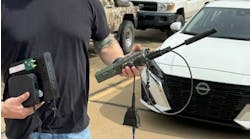Latest from Core/Legacy
Quiz: Are You a Telecom History Scholar?
400 Columns + One Farewell
Telephone cables designed for plain old telephone service (POTS) are now being used for The Triple Play. We are using bandwidth for ADSL, HDSL, T1, and IPTV. But before you go thinking it’s easy, be sure you examine and condition these old cable pairs, or you won’t provide the bandwidth your customers expect and deserve.
Conductor Insulation
Conductor insulation has changed over the years from the original paper insulation to pulp insulation and finally to plastic. Air-core cables were and are being replaced with filling compounds, and splicing techniques and closures have changed. No matter what kind of insulation is used for bandwidth, a quality cable pair with good pair balance within the reach of the particular service is necessary.
Paper Insulation
Original telephone cables were insulated with paper. From 1885 to 1910 longitudinal-wrapped paper was used. But longitudinal-wrapped paper had poor coaxial conductor capacitance. An improved spiral-wrapped paper was introduced in 1910; concentric layer construction was used. However, these larger cables were hard to work with. Fortunately most of these older cables have been replaced, and it is rare to see these cables in the distribution plant.
Pulp Insulation
In 1930, pulp insulation and unit type construction was introduced. Pulp is basically paper mache that is pumped into a cylinder mold where the water runs through, leaving the pulp on a fine mesh screen. The pulp is deposited into trays and the conductor is pressed into it. The insulation is rounded out for good coaxial capacitance and dried down to 4% relative humidity.
Conductors are twisted into pairs and pairs are made into 26, 51, and 101 pair units. Cable shields were originally made of lead. In 1952, Alpeth and Stalpeth sheath was introduced. To date, at least 30% of all cables are pulp-insulated. They are found in feeder plant leaving central offices, typically in conduit runs.
If these pulp cables are free of faults and have good pair balance within the reach, then they will transmit bandwidth with less interference from other circuits than plastic insulated conductors (PIC). For this reason, pulp cables are usually in conduit runs leaving central offices. Cables are wild spliced so no two circuits will lay side-by-side for more than one manhole. The only requirement is twisted unsoldered splices must be replaced with mechanical connectors to eliminate series resistance.
The downside of pulp cable is that it requires a proactive air pressure program to prevent the ingress of water. This program is in place, but reactive managers pull air pressure technicians from the program and place them in the load.
Plastic Insulated Conductors
Plastic insulated conductors (PIC) cables were introduced in 1951. An acceptable color code which always distinguished the tip and ring conductors was developed, and an even-count PIC was accepted.
The first plastics were low-density polyethylene, high-density polyethylene, and polypropylene. These cables were air-core and susceptible to water ingress. Water ingress in PIC air-core cable drastically degrades DSL signals, so it must be identified and replaced. Compounds are used to effectively remove the water but they change the impedance of the cables, and make all test equipment inaccurate and also affect the quality of the DSL. My suggestion is to replace any “water-core” PIC.
Filling compounds were introduced to prevent the ingress of water, but the diameter of the insulation had to be increased to reduce the capacitance. This meant fewer cable pairs for sheath diameter. To correct this, dual extruded plastic insulation (DEPIC) was introduced. With DEPIC, expanded insulation is extruded over the conductor and a solid skin of high-density polyethylene is extruded over the foam. The diameter is approximately the same as solid air-core insulation.
Remember that all telephone cables were designed with a capacitance of .083 microfarads per mile to support low frequency transmission from 0 to 4 kHz. We are now using these same cables to send frequencies up to 2.3 MHz and higher. In order to do this, there are several requirements.
The majority of PIC cables are in The Last Mile for FTTN. There are strict requirements for using these cables for bandwidth. First, the cable pairs must be free of any DC type faults. Every short, ground, cross, battery cross, or split cable pair must be identified, located, and repaired. Cutting to clear is not an option.
Vacant cable pairs with DC type faults will couple AC signals into working circuits because of poor pair balance. For example, a vacant pair with a tip ground will have un-canceled AC on the ring conductor that will degrade the bandwidth on other adjacent working DSL circuits.
All splices must have 0 ohms resistance across the splice. Any series resistance, as little as 5 ohms difference between tip and ring, will decrease bandwidth. These splices must have 0 ohm bonding across the splice. They should be filled with forced encapsulatant to prevent the ingress of water.
Low frequency AC interference from the power company will saturate systems causing freezing, pixelization, and macro blocking, interfering with IPTV and also disrupting ADSL. Common grounding with the power company is a must. In some instances a DSL induction neutralization transformer is necessary, especially in subdivisions where single-phase power is buried.
Any laterals, left in unused drops at other terminals or pedestals, bridged tap beyond the customer, must be identified and removed. Any extra wire as little as three feet can decrease bandwidth.
If your terminals and pedestals are in quality shape with good bonding and grounding, and your cables are free of DC type faults, load coils, water, and bridged tap, and show good longitudinal balance, these paid-for 30-year-old cables will provide quality service for FTTN.
Signing Off
If you have questions, tips, or comments, send me an email at [email protected], give me a call at 831.818.3930, or post them on McCarty Forum at www.mccartyinc.com/forums/.




